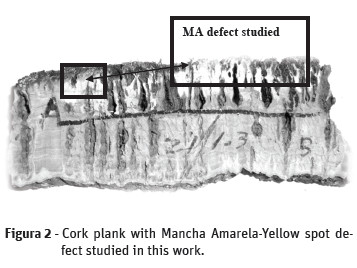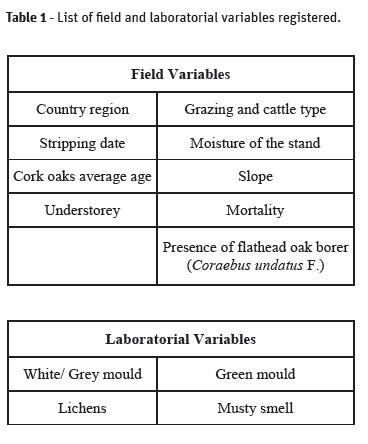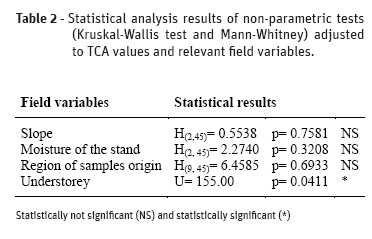Serviços Personalizados
Journal
Artigo
Indicadores
-
 Citado por SciELO
Citado por SciELO -
 Acessos
Acessos
Links relacionados
-
 Similares em
SciELO
Similares em
SciELO
Compartilhar
Revista de Ciências Agrárias
versão impressa ISSN 0871-018X
Rev. de Ciências Agrárias vol.38 no.2 Lisboa jun. 2015
ARTIGO
Stand factors related to sensory defects of cork planks
Fatores de campo relacionados com defeitos sensoriais da cortiça
Sandra Veloso1, Luís Bonifácio1, Eugénio Diogo1, Ana Paula Ramos2, Ana Magro3, José Pedro Fernandes4 and Helena Bragança1,*
1 Instituto Nacional de Investigação Agrária e Veterinária, I.P., Quinta do Marquês, 2780-159 Oeiras, Portugal. E-mails: helena.braganca@iniav.pt, author for correspondence; sandra.veloso@iniav.pt; luis.bonifacio@iniav.pt; eugenio.diogo@iniav.pt;
2 LEAF-Linking Landscape, Environment, Agriculture and Food, Instituto Superior de Agronomia, University of Lisbon, Tapada da Ajuda, 1349-017, Lisboa, Portugal. E-mail: pramos@isa.ulisboa.pt;
3 Instituto de Investigação Científica Tropical, Tapada da Ajuda, Edificio Ferreira Lapa, 3º piso, 1349-017, Lisboa, Portugal. E-mail: mico.anamagro@gmail.com
4 Amorim Florestal, SA. Unidade Industrial de Salteiros, Lugar de Salteiros - Longomel, 7400-402 Ponte de Sor, Portugal. E-mail: jpfernandes.afl@amorim.com
ABSTRACT
Wine bottle stoppers are the main bio-technological product obtained from cork. The 2,4,6-trichloroanisole (TCA) is considered the main responsible for “cork taint” in bottled wines. This study intent to prove the relation between TCA and mancha amarela-yellow spot (MA) and to identify field factors that can be related to the cork TCA presence. Cork planks with and without MA were collected from cork oak stands in ten different regions of the country and 15 variables were analyzed. Three samples were taken from each plank for TCA quantification. The results show that TCA and MA are significantly related and that the TCA level is higher in cork samples coming from stands with shrubs in the understorey.
Keywords: mancha amarela-yellow spot; 2,4,6-trichloroanisole; understorey
RESUMO
As rolhas de cortiça são o produto tecnológico mais importante obtido a partir da cortiça. O 2,4,6-tricloroanisol (TCA) é considerado o principal responsável pelo “gosto a rolha” no vinho engarrafado. Este estudo tem como objetivo provar a relação entre TCA e mancha amarela-yellow spot (MA) e identificar os fatores de campo que possam estar relacionados com a presença de TCA na cortiça. Pranchas de cortiça com a presença do defeito MA e sem a presença de MA foram colhidas em dez regiões do país e 15 variáveis foram analisadas. De cada prancha foram retiradas três amostras para quantificação do TCA. Os resultados mostram que a presença de TCA e da MA estão significativamente relacionadas e que os valores de TCA são mais altos nas parcelas com matos do que nas parcelas sem matos.
Palavras-chave: mancha amarela, 2,4,6-tricloroanisol, subcoberto
Introduction
The cork oak (Quercus suber L.) occupies part of the Portuguese landscape woodlands called montado de sobro in Portugal. It's a multiple use agro-silvo-pastoral system characteristic of Mediterranean - continental regions, sparsely covered by trees and understorey formed by grassland formations, supporting high levels of biodiversity (Costa and Pereira, 2007). This artificial ecosystem requires intensive and active management to ensure its survival (Bugalho et al., 2011). Apart from cork production, these stands are becoming valorized as places for recreation, tourism and residential uses (Almeida and Pinto-Correia, 2012).
Portugal has 730,000 hectares of cork oak stands, representing about 33% of its total area (APCOR, 2014). The cork oak is distributed only in the western Mediterranean region, especially in areas with Atlantic influence like Morocco, Algeria, Tunisia, Italy, France, Spain and Portugal (Pereira, 2007). The cork and its sub products represent 2% of Portuguese exportations and 30% of all Portuguese forest products exportations, where the cork bottle stopper production represents about 70% of the cork industry exports (INE, 2014).
Mancha Amarela-Yellow spot (MA), a cork sensory defect, and few studies were made on this subject. The MA causes modifications in cork's structure and optical properties being a potential cause of wine cork stoppers taint (Rocha et al., 2005). This sensory defect is described as a mouldy paper smell or non-airy wet basement and can make a bottled wine completely undrinkable (Vlachos et al., 2008). Cork planks with MA are rejected for cork stoppers productions, since its presence is empirically related to 2,4,6-trichloroanisole (TCA) values which compromises the quality of cork, thus causing a huge loss for cork industry (Neto, 2005; Rocha et al., 1996; Rocha et al., 2005). However the MA concept is still ambiguous and may vary between the industrial units that assign that defect's name.
Volatile and non-volatile compounds soluble in ethanol or water can migrate to the wine, thus contributing to the wine sensorial properties (Rocha et al., 2005).The TCA, a volatile chlorinated compound, was reported as the chief cause of cork off-flavours (Felter et al., 2010; Teixeira et al., 2006) and the filamentous fungi metabolism is the main responsible for the presence of TCA (Maggi et al., 2008; Oliveira, 2011).
The present study aims to clarify if the MA defect is related with TCA levels on raw cork planks and in parallel to identify field factors that can be related with TCA cork presence. Despite being an exploratory work, the results obtained can be regarded as a valuable expansion of the existing knowledge about the factors to which the MA defect is correlated.
Materials and Methods
Selection, sampling of cork and determining 2,4,6 - Trichloroanisol (TCA) values
In a cork factory several raw cork samples, were randomly collected from different stack which came from ten regions geographically different (Figure 1).
From each region three stacks were considered. Each stack has represented an individual cork stand.
To screen for Mancha Amarela-Yellow spot (MA) cork planks were observed and three cork planks with MA were randomly taken from each lot. Cork samples of 20x20x20cm size were taken from each plank (Figure 2). Twelve samples from planks without MA were also collected as controls.

In Table 1 are listed the field data from the oak stands where the surveyed cork planks were obtained. Also are listed laboratorial variables based on the direct observation of the outer surface of the cork planks.

For TCA analysis chips with 200x30x3 mm size were removed from each sample and the remaining material was suitably packed into a sterile bag, labelled and sent to laboratory. The TCA values were determined by Gas Chromatography. Each chip was cut into small pieces of cork (5x5x5 mm) which were introduced into flasks. After, 20 ml of a 12% ethanol solution (value close to the alcohol content of wine) was added to measure the amounts of TCA. The same flasks were individually labelled with the reference region number, the lot number and the sample number. The equipment used was a GC / ECD- Varian CP3800 chromatograph; 20 mL vials with 20 mm magnetic capsules and silicone septum; polidimetilsiloxane fiber (PDMS) of 100 m and nonpolar column.
Statistical analysis
The TCA values were statistically correlated to the MA cork samples variable, the field and laboratory variables. A multiple correspondence analysis (MCA) was used to assess the most relevant variables that would later be individually analyzed (Oliveira, 2002), with non parametric statistical methods (Kruskall-Wallis, Mann-Whitney tests), after evaluating data normality (Levene test). Statistical treatments were made using Statistic Software (version 6.1 - StatsoftInc, 2003).
Results
The results revealed that TCA values of all control samples had TCA levels below 1 ng/L, as expected.
The statistical analysis of the results showed that the parametric methods could not be applied (Levene test: F(1,43)= 8,0071; p= 0,0071) and the frequencies distribution histogram of TCA values did not follow the normality.
The Mann-Whitney test revealed statistically significant differences between the TCA values of control samples and those of MA samples (Z adjusted =5.0913; p<0,05) and is represented in Figure 3.
The Multiple Correspondent Analyses [MCA] adjusted to the field variables highlighted as more relevant for the MA and high TCA presence, the understorey and slope (positive), the region of origin (negative) (Fig. 4a) and the moisture of the stand (Fig. 4b). Laboratory variables white/ green mould, musty smell and lichens are also strongly related to MA and high TCA levels.
The results of nonparametric tests to assess the variation of TCA levels according to the field variables considered most relevant (Kruskal-Wallis test and Mann-Whitney test) are on Table 2.

Only the understorey variable seems to affect significantly the TCA values (U = 155.00, p = 0.0411). The average levels of TCA in planks coming from stands with bushes are higher than the average levels of TCA in planks coming from oak stands without understorey (Table 3).

Finally, according to the results of the nonparametric tests, the TCA levels are not statistically correlated to none of the laboratory variables (Table 4)
Discussion and Conclusions
Cork stoppers are a natural product, and cork can be contaminated in different ways that can affect its proprieties (Rocha et al., 2005).
Yellow-Spot (MA) is a cork sensory defect that, supposedly, is the result of filamentous fungi development, because some of them are usually associated with the presence of 2,4,6-trichloroanisole (TCA) (Maggi et al., 2008; Oliveira, 2011).
The purpose of this study was to relate MA defect with TCA levels present in the cork, which was confirmed. Therefore cork planks with MA should be taken away from cork stopper industry. Are the filamentous fungi responsible for that relationship? To answer this question further studies are already being carried out.
Other purpose of this study was to relate the stand factors, obtained from a query to the owners, with TCA levels in the cork. From all variables considered, only the presence/absence of understorey on the cork oak stands was highly significantly correlated with TCA levels. In fact, the planks with high TCA levels were obtained from stands with shrubs in the understorey. Have the filamentous fungi found good conditions for their development on stands with shrubs in the understorey? Are those conditions humidity, food, and host or is there anything else more?
It should be emphasized that this was an exploratory study that allowed to reveal directions to more detailed studies that should be fulfilled in the near future about the conditions that induce the presence of TCA in cork planks.
Acknowledgements
Authors acknowledge the Amorim Florestal S.A. company for the financial support and help for field data and also the Instituto Nacional de Investigação Agrária e Veterinária, I.P, the Instituto Superior de Agronomia of the University of Lisbon and the Instituto de Investigação Científica Tropical, for its staff and facilities.
References
Almeida, M. and Pinto-Correia, T. (2012) - Novas procuras na paisagem rural do Alentejo: as visões e preferências dos urbanos. Revista da Faculdade de Letras – Geografia – Universidade do Porto, vol. 1, p. 101–121. [ Links ]
APCOR (Associação Portuguesa da Cortiça). Disponível em http://www.apcor.pt/artigo/comercializacao-cortica.htm, accessed January 2014. [ Links ]
Bugalho, M.N.; Caldeira, M. C.; Santos Pereira, J.; Aronson, J. and Pausas, J. G. (2011) - Mediterranean cork oak savannas require human use to sustain biodiversity and ecosystem services. Frontiers in Ecology and the Environment, vol. 9, p. 278–286. [ Links ]
Costa, A. and Pereira, H. (2007) - Montados e sobreirais: uma espécie, duas perspectivas. In: Silva, J. S. (ed). Os montados – muito para além das árvores. Collection: Árvores e Florestas de Portugal. Público, Comunicação Social, S.A. e Fundação Luso-Americana para o desenvolvimento, p. 17-37. [ Links ]
Felter, R.; Álvarez-Rodríguez, M.L.; Barreiro, C.; Godio, R.P. and Coque, J.J.R. (2010) - Characterization of a novel 2,4,6- trichlophenol - inducible gene encoding clorophenol O-methyltransferase from Trichoderma longibrachiatum responsible for the formation of chloroanisoles and detoxification of chlorophenols. Fungal Genetics and Biology, vol.47, p. 458-467. [ Links ]
INE (Instituto Nacional de Estatística). Disponível em http://www.ine.pt/xportal/xmain?xpid=INE&xpgid=ine_main, accessed January 2014. [ Links ]
Maggi, L.; Mazzoleni,V.; Fumi, M.D. and Salinas, M.R. (2008) - Transformation ability of fungi isolated from cork and grape to produce 2,4,6-trichloroanisole from 2,4,6-trichlorophenol. Food Additives and Contaminants, vol.25, n. 3, p. 265-269. [ Links ]
Neto, C.V. (2005) - Compostos voláteis associados a defeitos de cortiça de Quercus suber L. Estudos dos efeitos de matriz por micro-extração em fase sólida na região de espaço cabeça. Tese de Mestrado. Aveiro, Universidade de Aveiro. 110 p. [ Links ]
Oliveira, R. (2002) - Aplicação de uma técnica de análise multivariada (Análise de Componentes Principais - ACP) para a descrição de dados de monitorização de séries de lagoas tratando águas residuais domésticas no nordeste do Brasil. In: Proceedings ”XXXVIII Congresso Interamericano de Engenharia Sanitária e Ambiental”. Cacun, México, October, p. 27-31. [ Links ]
Oliveira, B.R. (2011) - Identification fingerprinting of cork fungi: a phenetic approach. Tese de Mestrado. Lisboa, Faculdade de Ciências da Universidade de Lisboa, 44 p. [ Links ]
Pereira, H. (2007) - Cork: Biology, Production and Uses. Elsevier Publications, 336 p. [ Links ]
Rocha, S.M.; Delgadillo, I. and Correia. A.J.F. (1996) - GC-MS Study of Volatiles of Normal and Microbiologically Attacked Cork from Quercus suber L. Journal of Agricultural and Food Chemistry, vol. 44, p. 865-871. [ Links ]
Rocha, S.M.; Ganito S.; Barros A.; Carapuça H.M. and Delgadillo I. (2005) - Study of cork (from Quercus suber L.) – wine model interactions based on voltammetric multivariate analysis. Analytica Chimica Acta, vol. 528, p. 147-156. [ Links ]
Teixeira, M.I.V.; San Romão, M.V.; Bronze, M.R. and Vilas Boas, L. (2006) - 2,4,6-trichloroanisole: a consumer panel evaluation. Ciência Técnica Vitivinícola, vol. 21, n. 2, p. 53-65. [ Links ]
Vlachos, P.; Stathatos, E.; Gerasimos, L. and Panagiotis, L. (2008) - Gas-phase photocatalytic degradation of 2,4,6-trichloroanisole in the presence of a nanocrystalline Titania film. Applications to the treatment of cork stoppers. Catalysis Communications, vol. 9, p. 1987-1990. [ Links ]
Submitted/Submetido: 2015.03.16
Accepted/Aceite: 2015.06.08














